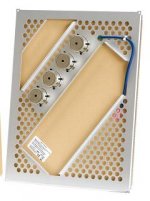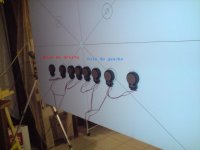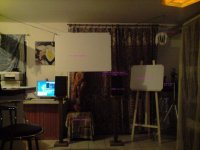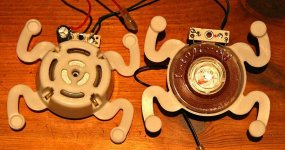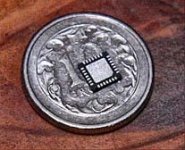I've been wondering how good the sound would be making something like the Infraplanars or Podiums, perhaps using old drivers, fill up the cone with polystyrene foam & clamp them to a piece of ply…???
Just found this thread, so I've got a bit of reading to do;
FWIW, I found the attached photo of the rear of a wall panel speaker; any thoughts on why the drivers are offset rather than down the middle?
Just found this thread, so I've got a bit of reading to do;
FWIW, I found the attached photo of the rear of a wall panel speaker; any thoughts on why the drivers are offset rather than down the middle?
Attachments
Hi,
to get good sonic quality, it is important to excite the modes of
a membrane as evenly as possible.
You can get an impression of the adequacy of several points
of excitation by using this applet.
http://www.falstad.com/membrane/
You can choose whether the edges are fixed or free in this
simulation. Unfortunately there is only a single point of excitation
possible, but i like the applet very much ...
Kind Regards
Oliver
to get good sonic quality, it is important to excite the modes of
a membrane as evenly as possible.
You can get an impression of the adequacy of several points
of excitation by using this applet.
http://www.falstad.com/membrane/
You can choose whether the edges are fixed or free in this
simulation. Unfortunately there is only a single point of excitation
possible, but i like the applet very much ...
Kind Regards
Oliver
PeteMcK said:
FWIW, I found the attached photo of the rear of a wall panel speaker; any thoughts on why the drivers are offset rather than down the middle?
My answer is: "Because a well chosen excitation point away from
the middle results in a more evenly distribution of excited modes,
which in turn leads to a more flat frequency response and better
transient response."
When the edges are free, excitation from the middle might be
an easy way to get more bass from the panel, but the price
to pay in terms of quality loss is very high ...
> When the edges are free, excitation from the middle might be
an easy way to get more bass from the panel, but the price
to pay in terms of quality loss is very high ...
Hello
I have done quite a lot of tests, and, as usual there are some compromises to keep in mind
We want the most of bass extension, the best output per Watt, the widest bandwidth, and as little ripples as possible...
Best bass comes from the center, best highs comes from a single exciter, best output from the lightest panel, plus big number of drivers, best bandwidth from ... I dont know exactly !
today my best compromise is with 2x4 drivers in one single stereo source at 1/3 of panel width.
an easy way to get more bass from the panel, but the price
to pay in terms of quality loss is very high ...
Hello
I have done quite a lot of tests, and, as usual there are some compromises to keep in mind
We want the most of bass extension, the best output per Watt, the widest bandwidth, and as little ripples as possible...
Best bass comes from the center, best highs comes from a single exciter, best output from the lightest panel, plus big number of drivers, best bandwidth from ... I dont know exactly !
today my best compromise is with 2x4 drivers in one single stereo source at 1/3 of panel width.
Attachments
the main quality of this configuration is "coherence"
but I must admit that I dont like the sound of the panel itself
it is what we call in french "carton-plume"
something like "lightweight carton",
great output, 2x4W is enough to drive my neighbourghood crazy,
but not so nice sounding
I have to find a better panel, here in my Island, a not so easy task
POL
but I must admit that I dont like the sound of the panel itself
it is what we call in french "carton-plume"
something like "lightweight carton",
great output, 2x4W is enough to drive my neighbourghood crazy,
but not so nice sounding
I have to find a better panel, here in my Island, a not so easy task
POL
Maybe add some damping ?
First something you can remove from the panel again,
like textile tape ?
Maybe start near the edges, to supress reflections from
the edges.
Just for inspiration ...
http://www.goebel-audio.de
First something you can remove from the panel again,
like textile tape ?
Maybe start near the edges, to supress reflections from
the edges.
Just for inspiration ...
http://www.goebel-audio.de
> Maybe add some damping ?
this the main problem with this kind of structure
we want to kill bad resonances, and keep goods ones
my panel are suspended with ropes from the ceiling
the same panel with ropes gives 6dB more per Watt
instead of lying on something or put in a frame...
this the main problem with this kind of structure
we want to kill bad resonances, and keep goods ones
my panel are suspended with ropes from the ceiling
the same panel with ropes gives 6dB more per Watt
instead of lying on something or put in a frame...
Attachments
Get em' while they're cheap.........
http://www.parts-express.com/pe/sho...48&FTR=309-148&CFID=15011071&CFTOKEN=21232269
http://www.parts-express.com/pe/sho...48&FTR=309-148&CFID=15011071&CFTOKEN=21232269
Some raw thougts why DML sound different
Some thoughts on why Distributed Mode Loudspeakers sound
different than conventional speakers.
First there is to say, that most loudspeakers are DML at least in
considerable ranges of the audio spectrum.
If we look at a large flat panel DML, the way it operates has very much
in common with the body of a string instrument, say e.g. a violin or
a cello:
When a different note is played, there is not just a change in frequency
and the harmonic components between the two notes.
There is additionally a change in the spatial radiation pattern.
The harmonics of each note are each (potentially) send into different
preferred directions into the concert hall. Thereby taking different
preferred paths to the listener. A different note played is associated with
a different set of paths.
(Maybe in this way the instrument is perceived as a sound source of
unique spectrum dependent dispersion, which may contribute to the
perception of the room itself and the separation of the instrument
from other instruments of the ensemble.)
What if that spatial "multipath separation" contributes to what we call
"natural imaging" or the notion of a sonic impression beeing
"detailed" ?
This may especially hold, when a comlex sound coming from a multitude of
instruments (e.g. a string ensemble) is heard.
Now back to the difference between DML and an idealized "piston acting"
speaker. The latter does not resemble that "multipath separation" of
neighboured notes or two instruments exhibiting a slight different spectrum
and dispersion pattern, when playing the same note, right?
The DML mimics this effect. Thereby it may subjectively sound
"more detailed", less "nasty" and as a result "less like a speaker" in
the best case.
The acoustics of the listening room is utilized in a different manner,
letting the room sound in a greater variety than possible with a sound source
having a more or less "fixed" polar dispersion for neighboured frequencies.
Now the Question: Is it HiFi, what a DML does?
I'd like to answer with a further Question:
Is it Hifi what a piston acting speaker does ?
It is not that easy to decide in my Opinion, since we talk about some kind
of information, which has been (mostly) lost in the recording and cannot be
restored.
The piston type speaker sends the signal with a fixed dispersion into the
listening room, the DML does "pseudo stochastic path variation" even for
neighboured frequencies, given that its modal density is high enough in
the frequency range under question.
None of the two techiques - neither DML nor piston - are able to restore the
missing multipath information.
But i tend to the conclusion by now, that "stochastic path variation" may be
the more convenient way of reproduction for our hearing system.
When i play my current dipol DML design and compare it with my
dipol line arrays, which are using conventional speakers, the overall
polar dispersion pattern of both systems is very similar.
From the first moment my wife said things like "The DML sounds more spatial,
it is more natural to me, the other speaker cannot compete in this respect no
matter what you say."
Even when i insist, that the DML in the current state sounds somewhat
"foggy" with some recordings and lacks precision sometimes, she always
preferred the DML.
Strange thing is, that i can immedately understand what she means.
I am surprised how much sonic drawbacks of my current DML prototypes i am
willing to forgive, since the DML has something, the other speaker does not
have.
So i try to find out for myself, what would make a DML sound "neutral".
Neutrality has to be redefined when using a different kind of technology.
An example:
When aligning a conventional closed cabinet bass speaker, it has been
found, that the most "detailed" reproduction is not reached subjectively
when tuning the system aperiodically with a Qt=0.5. A slightly
higher Qt>=0.6 seems preferable to most listeners.
In the same way the transmission characteristics of a DML has to be
investigated and fine tuned to find a suitable matching between
measurement parameters and the inherent properties of our hearing system.
Since the DML is different than a conventional speaker, there is less practical
experience and knowledge about optimal sets of parameters (and there are
lots of parameters in a DML).
So the good news is, that there is further work, investigation and
experimenting to do in the field of DML.
Kind regards
Some thoughts on why Distributed Mode Loudspeakers sound
different than conventional speakers.
First there is to say, that most loudspeakers are DML at least in
considerable ranges of the audio spectrum.
If we look at a large flat panel DML, the way it operates has very much
in common with the body of a string instrument, say e.g. a violin or
a cello:
When a different note is played, there is not just a change in frequency
and the harmonic components between the two notes.
There is additionally a change in the spatial radiation pattern.
The harmonics of each note are each (potentially) send into different
preferred directions into the concert hall. Thereby taking different
preferred paths to the listener. A different note played is associated with
a different set of paths.
(Maybe in this way the instrument is perceived as a sound source of
unique spectrum dependent dispersion, which may contribute to the
perception of the room itself and the separation of the instrument
from other instruments of the ensemble.)
What if that spatial "multipath separation" contributes to what we call
"natural imaging" or the notion of a sonic impression beeing
"detailed" ?
This may especially hold, when a comlex sound coming from a multitude of
instruments (e.g. a string ensemble) is heard.
Now back to the difference between DML and an idealized "piston acting"
speaker. The latter does not resemble that "multipath separation" of
neighboured notes or two instruments exhibiting a slight different spectrum
and dispersion pattern, when playing the same note, right?
The DML mimics this effect. Thereby it may subjectively sound
"more detailed", less "nasty" and as a result "less like a speaker" in
the best case.
The acoustics of the listening room is utilized in a different manner,
letting the room sound in a greater variety than possible with a sound source
having a more or less "fixed" polar dispersion for neighboured frequencies.
Now the Question: Is it HiFi, what a DML does?
I'd like to answer with a further Question:
Is it Hifi what a piston acting speaker does ?
It is not that easy to decide in my Opinion, since we talk about some kind
of information, which has been (mostly) lost in the recording and cannot be
restored.
The piston type speaker sends the signal with a fixed dispersion into the
listening room, the DML does "pseudo stochastic path variation" even for
neighboured frequencies, given that its modal density is high enough in
the frequency range under question.
None of the two techiques - neither DML nor piston - are able to restore the
missing multipath information.
But i tend to the conclusion by now, that "stochastic path variation" may be
the more convenient way of reproduction for our hearing system.
When i play my current dipol DML design and compare it with my
dipol line arrays, which are using conventional speakers, the overall
polar dispersion pattern of both systems is very similar.
From the first moment my wife said things like "The DML sounds more spatial,
it is more natural to me, the other speaker cannot compete in this respect no
matter what you say."
Even when i insist, that the DML in the current state sounds somewhat
"foggy" with some recordings and lacks precision sometimes, she always
preferred the DML.
Strange thing is, that i can immedately understand what she means.
I am surprised how much sonic drawbacks of my current DML prototypes i am
willing to forgive, since the DML has something, the other speaker does not
have.
So i try to find out for myself, what would make a DML sound "neutral".
Neutrality has to be redefined when using a different kind of technology.
An example:
When aligning a conventional closed cabinet bass speaker, it has been
found, that the most "detailed" reproduction is not reached subjectively
when tuning the system aperiodically with a Qt=0.5. A slightly
higher Qt>=0.6 seems preferable to most listeners.
In the same way the transmission characteristics of a DML has to be
investigated and fine tuned to find a suitable matching between
measurement parameters and the inherent properties of our hearing system.
Since the DML is different than a conventional speaker, there is less practical
experience and knowledge about optimal sets of parameters (and there are
lots of parameters in a DML).
So the good news is, that there is further work, investigation and
experimenting to do in the field of DML.
Kind regards
Last edited:
clamped vs. free
Hi jzagaja,
in this applet you can switch between "clamped" and "free":
http://www.falstad.com/membrane/
Roughly speaking in clamped condition there is less motion near the edges.
Nodes and antinodes are distributed differently between both conditions with
same frequency and size of the panel.
For high quality reproduction we would need a surround which is free of
reflection, thereby mimicking a panel of infinite size.
The mechanical impedance of the surround then has to match the mechanical
impedance of the panel. This is somewhere between difficult and impossible
to achieve for the whole audio spectrum, since the mechanical impedance of
the panel varies with frequency.
Best
Hi jzagaja,
in this applet you can switch between "clamped" and "free":
http://www.falstad.com/membrane/
Roughly speaking in clamped condition there is less motion near the edges.
Nodes and antinodes are distributed differently between both conditions with
same frequency and size of the panel.
For high quality reproduction we would need a surround which is free of
reflection, thereby mimicking a panel of infinite size.
The mechanical impedance of the surround then has to match the mechanical
impedance of the panel. This is somewhere between difficult and impossible
to achieve for the whole audio spectrum, since the mechanical impedance of
the panel varies with frequency.
Best
Thanks Oliver. I was curious if it has influence on fundamental resonance and bass. Those exciters are connected in series and one has electrolytic capacitor and second has ceramic. Pretty unusual isn't it?
Best panel material for our pocket is Gatorfoam, Forex, Kapa and Foam-X - all from Alcan. The last one is cheaper recycled version of Kapa. Gatorfoam has been tried here and what about Forex which is much stiffer than all the rest? Anyone?
Best panel material for our pocket is Gatorfoam, Forex, Kapa and Foam-X - all from Alcan. The last one is cheaper recycled version of Kapa. Gatorfoam has been tried here and what about Forex which is much stiffer than all the rest? Anyone?
At least it is difficult to excite the fundamental resonance of
a panel from the center in clamped condition.
Excitation from the middle can excite the fundamental resonance
well if the edges are free.
I think the podium speakers are an example for that. But i do not
know exactly, how the podium's panels are suspended.
a panel from the center in clamped condition.
Excitation from the middle can excite the fundamental resonance
well if the edges are free.
I think the podium speakers are an example for that. But i do not
know exactly, how the podium's panels are suspended.
Hi jzagaja,
in this applet you can switch between "clamped" and "free":
http://www.falstad.com/membrane/
Roughly speaking in clamped condition there is less motion near the edges.
Nodes and antinodes are distributed differently between both conditions with
same frequency and size of the panel.
For high quality reproduction we would need a surround which is free of
reflection, thereby mimicking a panel of infinite size.
The mechanical impedance of the surround then has to match the mechanical
impedance of the panel. This is somewhere between difficult and impossible
to achieve for the whole audio spectrum, since the mechanical impedance of
the panel varies with frequency.
Best
Just for my edification, what does the term "surround" mean in this context?
- Status
- This old topic is closed. If you want to reopen this topic, contact a moderator using the "Report Post" button.
- Home
- Loudspeakers
- Planars & Exotics
- PIEZO NXT type panel
